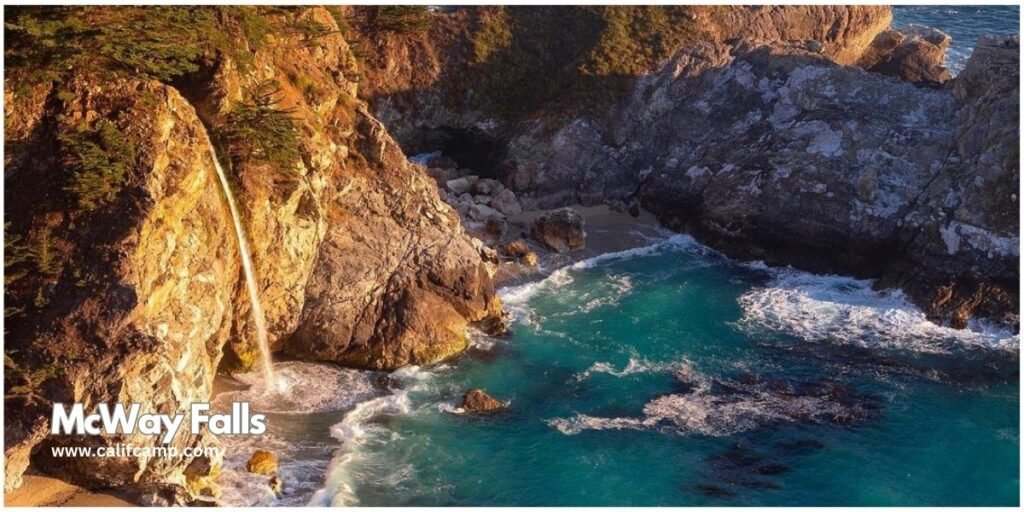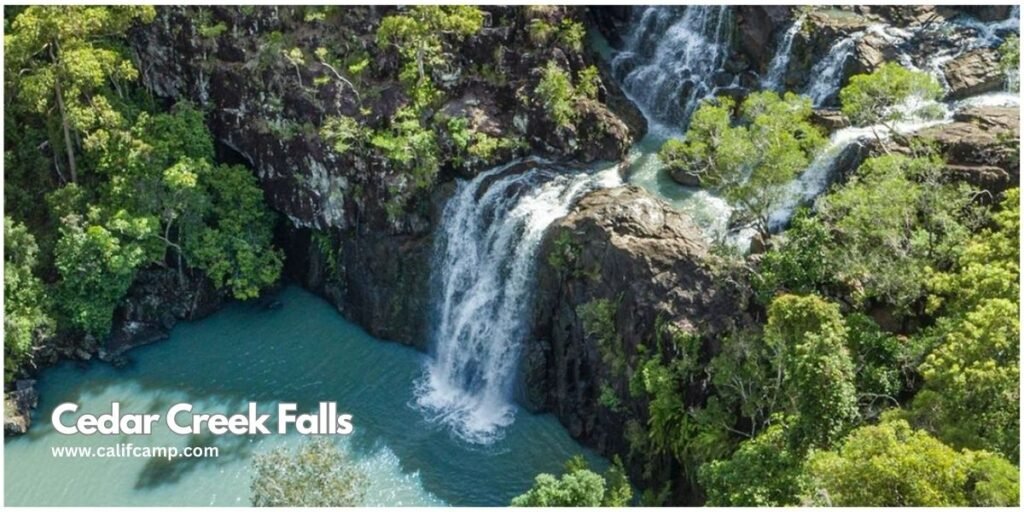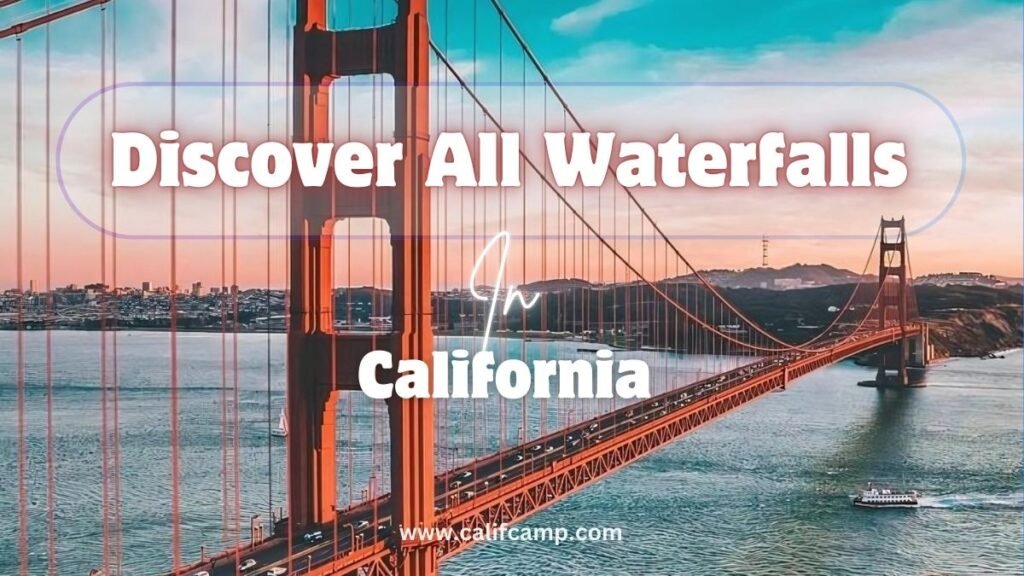California is home to a stunning variety of waterfalls, each offering its own unique experience. From the towering cascades of Yosemite in the north to the coastal falls of Big Sur and the hidden gems in Southern California, there’s a waterfall adventure waiting for every type of traveler. In this guide, we’ll explore all waterfalls in California and provide essential information on how to visit them.
Whether you’re planning a short hike or a day-long trek, this guide will help you discover the best waterfalls across the Golden State, along with tips on accessibility, scenic trails, and ideal visiting seasons.
Table of Contents
Northern California Waterfalls
Yosemite Falls
Yosemite Falls is not just the tallest waterfalls in California but the tallest in North America, standing at an impressive 2,425 feet. This majestic waterfall is divided into three sections—Upper Yosemite Fall, the Middle Cascades, and Lower Yosemite Fall. The sound of crashing water echoes through the valley, making it a must-see for visitors to Yosemite National Park.
For those looking to immerse themselves in this natural wonder, a 1-mile scenic loop trail offers breathtaking views of the Lower Falls, making it accessible even for casual hikers. The combination of its height, grandeur, and scenic surroundings makes Yosemite Falls an unforgettable experience.

How to Visit
- Yosemite Falls is easily accessible within Yosemite National Park. Visitors can take the Lower Yosemite Fall Trail, which is a short and easy walk suitable for all skill levels.
- The best time to visit is during the spring when the snowmelt creates the most dramatic water flow.
- Parking is available nearby, but arriving early during peak seasons is recommended to avoid crowds.
- Additionally, the trail is wheelchair accessible, making it a great spot for families.
Burney Falls
Burney Falls, located in McArthur-Burney Falls Memorial State Park, is a breathtaking 129-foot waterfall that seems to come straight out of a fairytale. Known for its consistent water flow year-round, Burney Falls is fed by underground springs, giving it an ethereal appearance as water cascades over moss-covered rocks. The pool at the base of the falls is a brilliant blue, perfect for photography or a peaceful picnic. The falls are surrounded by lush greenery, making it a popular destination for nature lovers and families alike.

How to Visit
- To reach Burney Falls, head to McArthur-Burney Falls Memorial State Park.
- There is a parking area near the falls with easy access to the viewing platforms. The park charges a small entrance fee, which helps maintain the trails and facilities.
- The best time to visit is during the spring and summer months when the surrounding park is in full bloom, offering excellent opportunities for hiking and wildlife spotting.
Berry Creek Falls
Tucked within Big Basin State Park, Berry Creek Falls is a hidden gem that rewards hikers with stunning views after a 10-mile round-trip hike. The journey to the falls is as beautiful as the destination, winding through redwood forests and crossing creeks. At 65 feet tall, Berry Creek Falls is not as towering as some of California’s other waterfalls, but the serene setting makes it a favorite for those looking for a peaceful retreat into nature. The falls are best enjoyed during the wetter months when the flow is at its strongest.

How to Visit
- The hike to Berry Creek Falls is moderately challenging, requiring proper planning. The trail begins at Big Basin Redwoods State Park and is well-marked, but it can be steep and slippery in places. Bring plenty of water, wear sturdy hiking shoes, and plan for a full day to complete the hike.
- The trail offers several viewpoints along the way, so pack a camera to capture the beauty of the redwoods and the waterfall.
Central California Waterfalls
McWay Falls
McWay Falls, located in Julia Pfeiffer Burns State Park, is one of California’s most picturesque waterfalls, standing 30 feet tall and cascading directly into the Pacific Ocean. This rare tidefall creates a stunning sight as it tumbles from a granite cliff onto the sandy shore below, making it a favorite for photographers and nature enthusiasts. The contrast between the waterfall and the turquoise waters of the Pacific makes McWay Falls a must-see for anyone traveling through the iconic Big Sur coastline. Visitors are often captivated by the serenity of the area and the unique spectacle of a waterfall flowing directly into the sea.

How to Visit
- McWay Falls is easily accessible via a short, well-maintained trail that offers panoramic views of the waterfall and ocean.
- There are designated viewing platforms, allowing visitors to admire the falls without disturbing the fragile environment.
- Parking is available at Julia Pfeiffer Burns State Park, and it is recommended to arrive early, especially during peak tourist seasons, as parking can fill up quickly. There is a small entrance fee to the park.
Tokopah Falls
Towering at an impressive 1,200 feet, Tokopah Falls is the crown jewel of Sequoia National Park’s waterfalls. Located at the end of a scenic 4-mile trail, this waterfall is a magnificent sight, especially during the spring and early summer when snowmelt swells the river. The trail leading to the falls meanders alongside the Kaweah River, providing picturesque views of granite cliffs, alpine meadows, and lush forests along the way. The waterfall’s power and grandeur, set against the backdrop of Sequoia’s natural beauty, make it a rewarding destination for hikers and nature lovers.

How to Visit
- Visitors can reach Tokopah Falls by taking the Tokopah Valley Trail, which starts near the Lodgepole Campground in Sequoia National Park. The hike is moderate and family-friendly, making it suitable for most visitors.
- There is a small entry fee to access the park, and parking is available at the Lodgepole Visitor Center.
- The best time to hike is during the spring when the waterfall is at its fullest. Be sure to bring sturdy hiking shoes, plenty of water, and a camera to capture the breathtaking views.
Bridalvei Falls
Bridalveil Falls is a stunning 620-foot waterfall located in Yosemite National Park, known for its beautiful mist and rainbows on sunny days. The relatively short and easy 0.5-mile trail leads visitors to a close-up view of this majestic cascade, making it a popular spot for photography and soaking in the natural beauty. The falls are particularly captivating in spring when the snowmelt creates a powerful flow.

How to Visit
- Visitors can access Bridalveil Falls via a short paved trail from the parking area.
- The best time to visit is during spring when the waterfall is at its peak flow.
- There is a parking area close to the trailhead, but it can fill up quickly, especially on weekends. Arriving early is recommended to secure a spot.
McCloud Falls
McCloud Falls is a three-tiered waterfall located near Mount Shasta. The tallest tier drops 53 feet, and visitors can hike along the trail that offers stunning views of each tier, making it an excellent spot for photography, hiking, and picnicking amidst nature. The lush surroundings and peaceful atmosphere create an ideal escape into the wilderness.Insert Image: View of McCloud Falls cascading over the rocks.

How to Visit
- Accessing McCloud Falls is straightforward via a well-marked trail from the McCloud River Park.
- Parking is available at the park, and the best time to visit is in late spring when the water flow is abundant.
- The trail is relatively easy, making it suitable for families.
Southern California Waterfalls
Big Falls
Big Falls is a stunning 150-foot waterfall located in San Bernardino National Forest, known for being one of the tallest waterfalls in Southern California. The waterfall cascades down a steep granite cliff, creating a powerful and mesmerizing sight. It is particularly impressive during the spring and early summer months when the snowmelt from the surrounding mountains enhances the flow. Big Falls is relatively easy to reach, making it a popular destination for families and casual hikers looking to experience nature’s beauty without an extensive trek.

How to Visit
- The trailhead for Big Falls is located near Forest Falls, and the hike to the waterfall is just 1 to 2 miles, making it accessible for hikers of all levels.
- Parking is available near the trailhead, though visitors should be aware that parking can fill up quickly during peak seasons.
- The best time to visit is in the spring, and it’s essential to check weather conditions beforehand, as the waterfall can be more powerful and potentially hazardous after heavy rain.
Cedar Creek Falls
Cedar Creek Falls is a stunning 90-foot waterfall near Ramona, offering a rewarding destination after a 4-mile hike through the rugged hills of San Diego County. Known for its dramatic plunge into a deep swimming hole, Cedar Creek Falls is particularly popular during warmer months, when hikers take a refreshing dip in the pool beneath the waterfall. The journey to the falls takes you through a beautiful landscape of chaparral, oak trees, and granite rock formations, providing a scenic backdrop to this natural oasis.

How to Visit
- To visit Cedar Creek Falls, hikers must secure a permit, which is required to help preserve the natural beauty of the area.
- The trailhead begins at the San Diego River Gorge parking area, and the hike is moderately challenging, with little shade along the way. Bring plenty of water, sunscreen, and sturdy hiking shoes, as the trail can be steep in certain sections.
- The best time to visit is in the spring or fall when the weather is cooler and the waterfall is flowing after seasonal rains.
Tunnel Falls
Tunnel Falls is located in the Columbia River Gorge area, featuring a unique waterfall that cascades through a tunnel carved into the rock. The 100-foot waterfall offers a unique experience as visitors can walk behind the falls, providing a spectacular view and a refreshing mist. This distinctive feature makes it a favorite among adventurous hikers.Insert Image: View of Tunnel Falls with hikers walking behind it.

How to Visit
- To access Tunnel Falls, hikers can take the Eagle Creek Trail, which is approximately 3.5 miles long one way.
- The trail can be challenging, so it’s best for those with some hiking experience. Ensure you have proper gear and check trail conditions before visiting.
Burney Falls
Burney Falls, located in McArthur-Burney Falls State Park, features a remarkable 129-foot waterfall that appears to flow from the rocks above, creating a stunning visual. The surrounding area is perfect for picnics and offers multiple vantage points for photography. The falls are particularly breathtaking after winter rains, showcasing the beauty of nature in its full glory.

How to Visit
- To visit Burney Falls, head to McArthur-Burney Falls State Park, where a small admission fee is required.
- There are facilities, including picnic areas and restrooms, and the best time to visit is during spring and summer when the falls are most impressive.
Buck Creek Falls
Buck Creek Falls is a hidden gem located in the Klamath National Forest, featuring a breathtaking 40-foot drop surrounded by lush forest. The waterfall is often less crowded, making it an ideal spot for tranquility and nature photography. The peaceful environment provides a perfect escape for visitors looking to enjoy the beauty of the outdoors.Insert Image: Buck Creek Falls nestled in the forest.

How to Visit
- Accessing Buck Creek Falls requires a hike along a moderate trail of about 2 miles.
- The best time to visit is in spring when the water flow is strong.
- Parking is available at the trailhead, but be sure to check for any access restrictions due to seasonal conditions.
How to Visit Waterfalls in California
- Plan Your Trip: Research the waterfalls you want to visit and plan your itinerary accordingly. Consider factors such as the time of year, weather conditions, and hiking difficulty.
- Pack Essential Items: Bring comfortable hiking shoes, sunscreen, insect repellent, and plenty of water. If you plan to swim, bring a swimsuit and towel.
- Follow Safety Guidelines: Always stay on designated trails and avoid swimming in areas marked as dangerous. Be mindful of your surroundings and respect the natural environment.
California’s waterfalls offer a breathtaking variety of experiences across its northern, central, and southern regions. From the towering Yosemite Falls to the unique ocean plunge of McWay Falls, each location provides something special for outdoor adventurers and casual visitors alike. Whether you’re seeking a family-friendly outing or a challenging hike, these waterfalls have something for everyone. Start planning your trip with the tips provided, and be sure to check official park websites for the latest updates on permits, fees, and trail conditions.
Read More Post
Hiking Crystal lake trail irwindale wildlife 2024
FAQs About Waterfalls in California
Q: What is the best time to visit waterfalls in California?
The best time to visit waterfalls in California is during the spring, typically from March to May. This is when waterfalls are at their peak flow, fed by snowmelt in the mountains and winter rains. Northern and Central California waterfalls are particularly spectacular during this time, while Southern California waterfalls benefit from seasonal rains and are most impressive in the early months of the year.
Q: Are there any waterfalls that are accessible to people with disabilities?
Some waterfalls, such as Yosemite Falls and Bridalveil Fall, have accessible viewing areas. However, it’s always a good idea to check with the park service in advance.
Q: Can I swim in California’s waterfalls?
Swimming is allowed at some waterfalls, but it’s important to check the park regulations and be aware of potential hazards.
Q: How long does it take to hike to California’s waterfalls?
The hiking time to reach California’s waterfalls varies depending on the specific trail and the length of the hike. Some waterfalls can be reached with a short walk, while others require a more strenuous hike.



